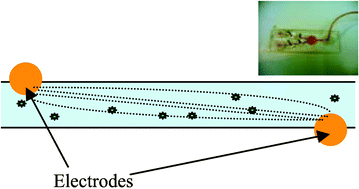A micro-scale multi-frequency reactance measurement technique to detect bacterial growth at low bio-particle concentrations
Abstract
The technique described enables the user to detect the presence and proliferation of bacteria through an increase in the bulk capacitance (C) of the suspension, which is proportional to the bacteria count, at practical frequencies less than 1 MHz. The geometry of the micro-capillary design employed increases the bulk resistance (R) of the medium, thus increasing its RC time. This makes the measured reactance sensitive to changes in the bulk capacitance, which is usually masked by the much larger surface capacitance. The sensitivity is further enhanced by the existence of a minimum in the value of the reactance at a frequency proportional to the inverse medium RC time. The value of this reactance minimum and the frequency at which the minimum is recorded are dependent on the bacteria count and permit the detection of an initial concentration of ∼100 CFU ml−1 of E. coli within 3 hours of incubation, in comparison with the previous reported values of about 8 hours, with an initial load of 1000 CFU ml−1.


 Please wait while we load your content...
Please wait while we load your content...